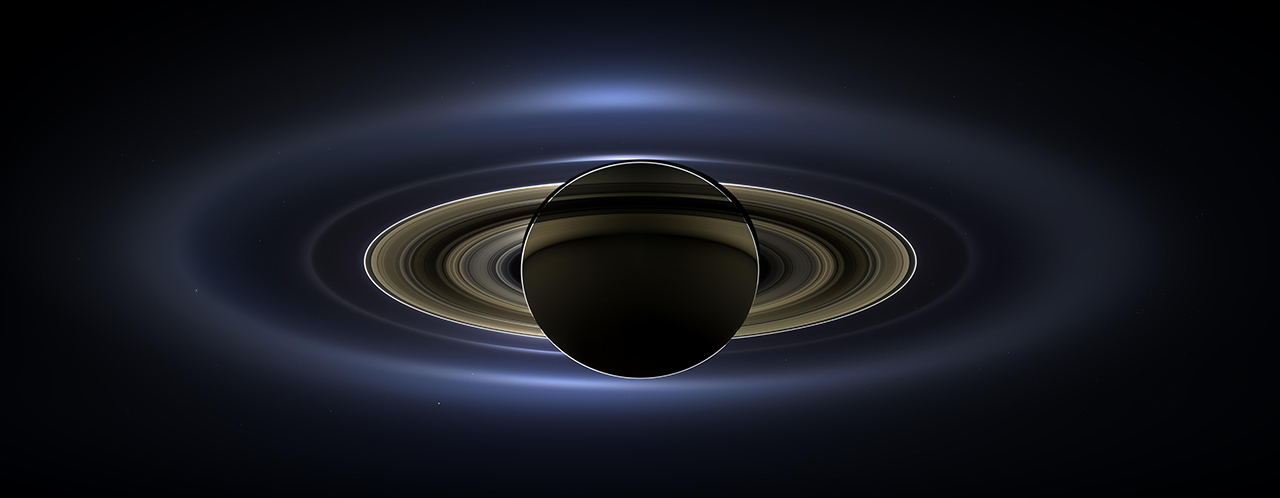
On July 19, 2013, in an event celebrated the world over, NASA's Cassini spacecraft slipped into Saturn's shadow and turned to image the planet, seven of its moons, its inner rings -- and, in the background, our home planet, Earth.
How It Worked
The Imaging Science Subsystem consisted of a wide-angle and a narrow-angle digital camera. The cameras were sensitive to visible wavelengths of light and to some infrared and ultraviolet wavelengths. Each camera had several filters mounted on wheels to select the wavelengths to be sampled in each image.
How We Used It
The Imaging Science Subsystem served as Cassini’s main set of eyes for viewing the Saturn system. It studied features as small as boulders and as large as Saturn’s rings. The instrument also assisted in navigation and captured the beautiful images for which Cassini is so well known.
Not to be confused with the International Space Station, which goes by the same acronym, Cassini’s Imaging Science Subsystem, or ISS, was a powerful camera system that sent back a steady stream of beautiful, science-packed images from Saturn.
Cassini's imaging system had two parts: a wide-angle camera (to provide context) and a narrow-angle camera (for higher resolution). The wide-angle camera captured broad scenes, such as the entirety of Saturn and its rings from more than a million miles (1.5 million km) away, while the narrow-angle camera provided higher-resolution images of specific targets, such as craters or fractures on the surfaces of Saturn’s moons.
The two cameras were similar in some ways to digital cameras on Earth. The wide-angle camera used lenses, while the narrow-angle camera used mirrors, to focus light on a detector called a Charge-Coupled Device (CCD) that converted light into a digital image made of pixels. But while today’s cameras on Earth have detectors with dozens of megapixels, Cassini’s cameras -- built in the early 1990s -- were closer to 1 megapixel.
Cornell University planetary scientist Peter Thomas, a member of the imaging team who studies Saturn’s moons with Cassini’s cameras, said the cameras were far more carefully calibrated than Earth cameras and were built to survive more than 10 years in the harsh conditions of outer space. The cameras were built so well, in fact, that they continued capturing mind-blowing images nearly 20 years after the spacecraft left Earth.
Cassini’s cameras provided far more information than consumer-level digital cameras because they were sensitive to all wavelengths of light between the near-ultraviolet and the near-infrared, a range greater than typical visible-light cameras. Each camera had a variety of color filters mounted on wheels that selected the range of wavelengths, or color, for the camera to record with each image.
Using the different filters helps researchers investigate specific aspects of the Saturn system. For example, by using a filter that blocks all but ultraviolet light, researchers could study high hazes in the atmospheres of Saturn and Titan. Or, using a filter that blocks all but certain infrared wavelengths, researchers could peer through the obscuring smog in the atmosphere of Saturn's moon Titan to reveal its surface. Thomas said the imaging team was pleased that some of Titan’s surface was visible in the near-infrared. “We weren’t totally confident beforehand that we’d be able to do that,” he says. “But the filters were well-chosen.”
Cassini’s cameras helped researchers study the structure and motion of Saturn’s and Titan’s atmospheres. They also studied the size, thickness, composition and other characteristics of Saturn’s rings, and how Saturn’s moons and rings interact through gravity.
By taking lots of pictures, the cameras created maps of the moons’ surfaces, Saturn’s rings and the planet itself. Researchers also use the images to understand the moons’ topography (the heights and shapes of features on the surfaces), composition (what materials those features are made of), and to measure the orbits, shapes and sizes of Saturn’s moons with exquisite precision.
The cameras were included on the Cassini spacecraft for scientific purposes, but the bonus is that Earthlings get to see Saturn’s exotic beauty closer, clearer and sharper than we ever could from Earth. Cassini’s cameras captured views in color by taking three images, each with a different color filter, which were then combined back on Earth. The resulting images show us Saturn as our eyes would see it had we actually been there, silently orbiting Saturn alongside Cassini.
In addition to scientific observations and beautiful spacescapes, Cassini also used the narrow-angle camera for navigation (the wide-angle camera was also capable of doing the job if needed). A spacecraft navigating in outer space is similar to a backpacker navigating in the wilderness, but instead of landmarks, a map and a compass, Cassini used the known positions of Saturn’s moons along with a map of the stars to determine its position based on its images. “It’s a crucial item for tweaking the orbit,” Thomas said.
At a Glance
- Wide Angle Camera [WAC](20 cm f/3.5 refractor; 380-1100 nm; 18 filters; 3.5ox3.5o)
- Narrow Angle Camera [NAC](2 m f/10.5 reflector; 200-1100 nm; 24 filters; 0.35ox0.35o)
- Mass (current best estimate) = 57.83 kg
- Peak Operating Power (current best estimate) = 55.90 W
- Peak Data Rate (current best estimate) = 365.568 kilobits/sec
- Dimensions (approximate) = 95x40x33 cm (NAC); 55x35x33 cm (WAC)
- Mass (current best estimate) = 57.83 kg
- Peak Operating Power (current best estimate) = 55.90 W
- Peak Data Rate (current best estimate) = 365.568 kilobits/sec
- Dimensions (approximate) = 95x40x33 cm (NAC); 55x35x33 cm (WAC)


